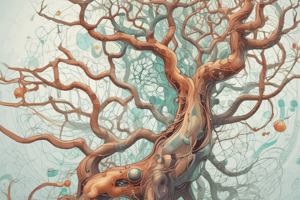Podcast
Questions and Answers
What is the primary function of mitochondria in a cell?
What is the primary function of mitochondria in a cell?
- Control center of the cell
- Powerhouse of the cell (correct)
- Storage of genetic information
- Protein production
Which of the following is a characteristic of a eukaryotic cell?
Which of the following is a characteristic of a eukaryotic cell?
- True nucleus (correct)
- Cell wall only in plant cells
- No nucleus
- Only found in animals
What is the primary function of the cell membrane?
What is the primary function of the cell membrane?
- To provide structure and support
- To store genetic information
- To control what enters and leaves the cell (correct)
- To produce proteins
What is the main difference between biotic and abiotic factors in an ecosystem?
What is the main difference between biotic and abiotic factors in an ecosystem?
What is the result of the energy loss at each trophic level, according to the rule of 10?
What is the result of the energy loss at each trophic level, according to the rule of 10?
What is the process of making energy from sunlight, according to the text?
What is the process of making energy from sunlight, according to the text?
Flashcards are hidden until you start studying
Study Notes
Cell Theory
- Cells are the basic units of structure and function in living things
- Cells come from other cells
- All living things are made up of cells
Cell Types
- Prokaryotic cells: cells with no nucleus
- Eukaryotic cells: cells with a true nucleus
Cell Structures and Functions
- Mitochondria: powerhouse of the cell
- Nucleus: control center of the cell
- Cell membrane: semi-permeable membrane that controls what enters and leaves
- Cell wall: rigid wall outside the cell membrane in plant cells
- Ribosomes: produce proteins
- Chloroplasts: contain chlorophyll and are responsible for photosynthesis
- Vacuole: storage tanks
Organ Systems
- Circulatory system: circulates blood and oxygen throughout the body
- Digestive system: breaks down food so the body can absorb
- Respiratory system: takes in oxygen and releases carbon dioxide
- Muscular system: provides movement, digestion, etc.
- Skeletal system: provides support and structure
- Nervous system: transmits messages and processes information
Ecosystems
- Biotic factors: living things
- Abiotic factors: non-living things
Energy Flow
- Rule of 10: 10% energy loss at each trophic level
Photosynthesis and Cellular Respiration
- Photosynthesis: process of making energy from sunlight
- Cellular respiration: process of breaking down substances into simpler substances for energy
Relationships
- Mutualism: both organisms benefit
- Commensalism: one organism benefits, the other is neither harmed nor helped
- Parasitism: one organism benefits, the other is harmed
Genetics
- Dominant traits: represented by capital letters, cover recessive traits
- Recessive traits: represented by lowercase letters, only show if two recessive alleles are present
- Genetic mutations: changes in the DNA sequence
Studying That Suits You
Use AI to generate personalized quizzes and flashcards to suit your learning preferences.




